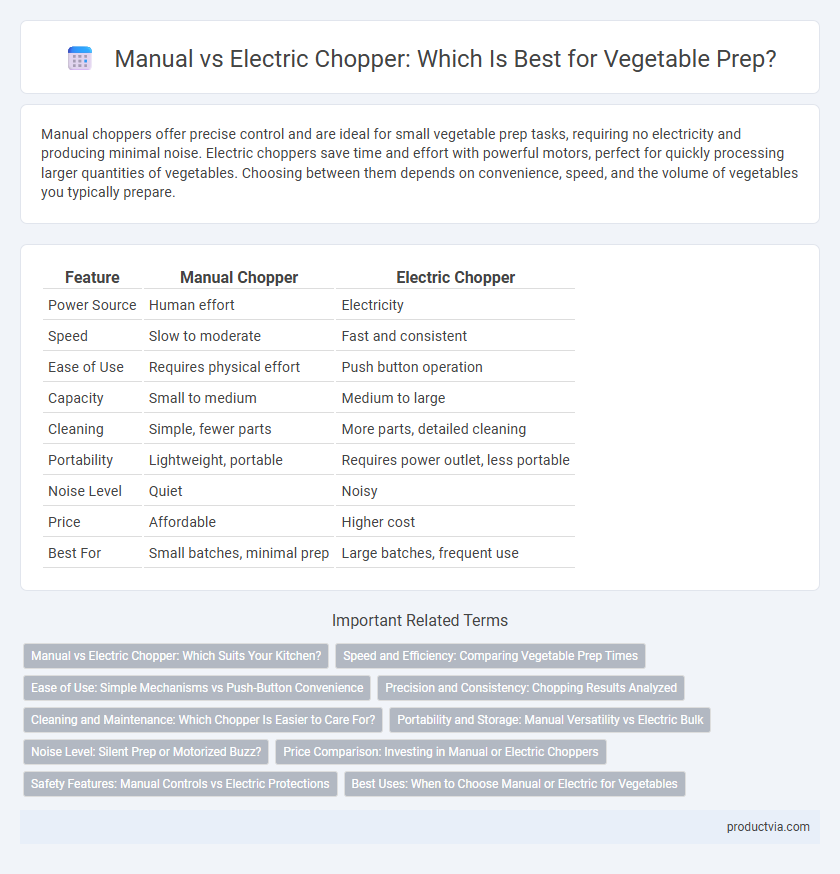Manual choppers offer precise control and are ideal for small vegetable prep tasks, requiring no electricity and producing minimal noise. Electric choppers save time and effort with powerful motors, perfect for quickly processing larger quantities of vegetables. Choosing between them depends on convenience, speed, and the volume of vegetables you typically prepare.
Table of Comparison
| Feature | Manual Chopper | Electric Chopper |
|---|---|---|
| Power Source | Human effort | Electricity |
| Speed | Slow to moderate | Fast and consistent |
| Ease of Use | Requires physical effort | Push button operation |
| Capacity | Small to medium | Medium to large |
| Cleaning | Simple, fewer parts | More parts, detailed cleaning |
| Portability | Lightweight, portable | Requires power outlet, less portable |
| Noise Level | Quiet | Noisy |
| Price | Affordable | Higher cost |
| Best For | Small batches, minimal prep | Large batches, frequent use |
Manual vs Electric Chopper: Which Suits Your Kitchen?
Manual choppers offer precise control and quiet operation, making them ideal for small kitchens and quick vegetable prep tasks without electricity dependency. Electric choppers excel in efficiency and speed, handling larger quantities effortlessly and reducing prep time significantly for busy cooks. Choosing between manual and electric depends on kitchen size, usage frequency, and the volume of vegetables typically prepared.
Speed and Efficiency: Comparing Vegetable Prep Times
Manual choppers require more physical effort and generally take longer to process large quantities of vegetables, averaging around 5-7 minutes for a medium batch. Electric choppers significantly reduce prep time, often completing similar tasks in 1-2 minutes due to their motorized blades and consistent chopping power. This speed advantage makes electric choppers more efficient for frequent or extensive vegetable preparation.
Ease of Use: Simple Mechanisms vs Push-Button Convenience
Manual choppers offer ease of use through simple mechanisms, requiring only a twisting or pulling action to chop vegetables efficiently, making them ideal for quick, cordless prep. Electric choppers provide push-button convenience, enabling effortless operation with consistent chopping results and reducing physical effort, especially for larger quantities. Choosing between manual and electric depends on kitchen workflow preferences and the desired balance between control and automation.
Precision and Consistency: Chopping Results Analyzed
Manual choppers offer greater control over chopping precision, allowing users to adjust speed and pressure for customized vegetable sizes, which results in varied texture suitable for different recipes. Electric choppers deliver consistent, uniform cuts with powerful blades and timed pulses, minimizing human error and ensuring even cooking. Precision in manual chopping enhances texture diversity, while electric choppers excel in consistent results, making each option ideal depending on the desired culinary outcome.
Cleaning and Maintenance: Which Chopper Is Easier to Care For?
Manual choppers feature fewer components and no electrical parts, simplifying cleaning and reducing maintenance efforts. Electric choppers often have detachable, dishwasher-safe blades and bowls, but require careful handling of motor units to avoid damage. For ease of care, manual choppers generally offer quicker cleaning with minimal risk of malfunction.
Portability and Storage: Manual Versatility vs Electric Bulk
Manual choppers offer superior portability and compact storage, making them ideal for small kitchens or on-the-go use, as they do not require power sources or bulky components. Electric choppers, while efficient for bulk vegetable prep, tend to be heavier and larger, demanding more counter space and dedicated storage areas. Choosing between the two depends on balancing portability and ease of storage against the volume and frequency of food preparation.
Noise Level: Silent Prep or Motorized Buzz?
Manual choppers offer silent prep, making them ideal for quiet kitchens or early mornings without disturbing others. Electric choppers produce a motorized buzz, which can be louder but significantly speeds up vegetable preparation. Choosing between the two depends on balancing noise tolerance with efficiency needs.
Price Comparison: Investing in Manual or Electric Choppers
Manual choppers generally have a lower upfront cost, making them an affordable option for basic vegetable prep without electricity dependence. Electric choppers, while pricier, offer greater efficiency and speed, which can justify the investment for frequent or large-scale food preparation. Choosing between manual and electric depends heavily on budget constraints and the volume of vegetable chopping typically required.
Safety Features: Manual Controls vs Electric Protections
Manual choppers rely on manual controls that offer precise handling and reduce the risk of accidental activation, making them inherently safer for novice users. Electric choppers incorporate built-in safety protections such as automatic shutoff mechanisms, locking lids, and overload sensors to prevent accidents and equipment damage. Choosing between manual and electric models depends on the user's comfort with manual operation versus the enhanced safety features provided by electric devices.
Best Uses: When to Choose Manual or Electric for Vegetables
Manual choppers excel in prepping small quantities of vegetables quickly, offering precise control for tasks like chopping herbs, garlic, or onions without the need for electricity, making them ideal for camping or quick meal setups. Electric choppers handle larger volumes efficiently, delivering consistent, uniform cuts ideal for soups, stews, or meals requiring finely chopped vegetables in bulk, saving time and effort in busy kitchens. Choose a manual chopper for portability and simple chopping tasks, while an electric chopper suits heavy-duty vegetable prep with speed and versatility.
Manual chopper vs Electric chopper for vegetable prep Infographic

 productvia.com
productvia.com